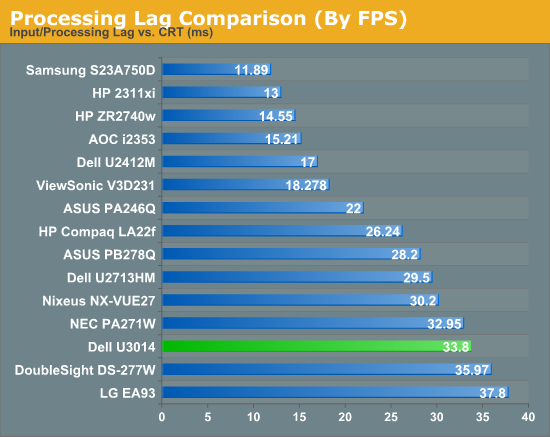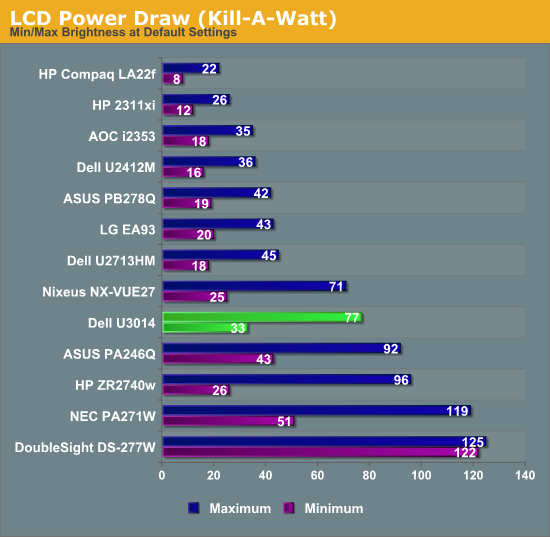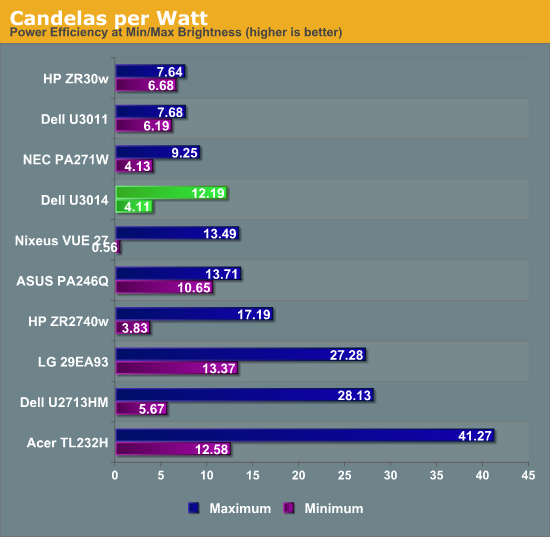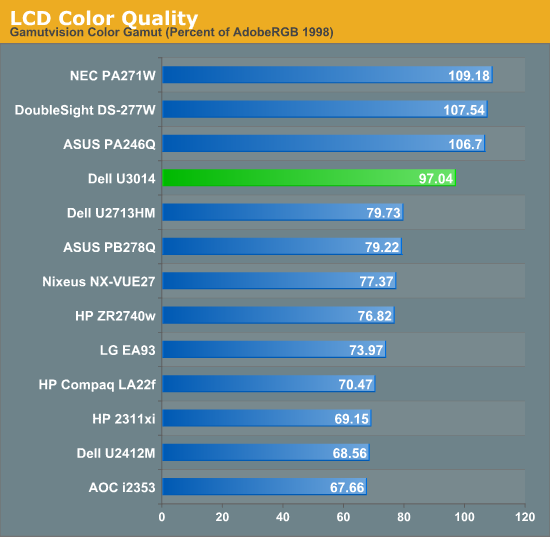Dell U3014 LCD Review
by Chris Heinonen on April 15, 2013 2:00 PM ESTUnfortunately, as I went to test this display using SMTT, which I’ve used for the past year, I found my license has expired. Furthermore, the author has stopped selling licenses right now, so we can’t use it anymore. This is unfortunate as it let us easily determine input lag versus pixel response time, and nothing else does that as well. With that gone, I went to three different options to test the lag on the Dell U3014:
- The Leo Bodnar Lag Tester
- FlatPanelsHD lag timer
- 3DMark03
Using the FlatPanelsHD test, it was a straight 49 or 50ms each time on the U3014. Since you have to mirror this on a CRT, that means running at 1920x1080 resolution on the Dell so the usual caveats apply, though it was the same lag with 1:1 pixel mapping or with scaling, so at least that introduces no additional penalty.
Using 3DMark03, I managed to measure right around 37.3ms, and with the Leo Bodnar lag tester I measured 33.8ms. All of these were while running in Game Mode, so the least input lag that I saw was two frames. Because I don’t live in a vacuum, I also looked at the results that TFT Central managed with the same display, since they have an oscilloscope that I don’t and they found virtually no lag at all. I think the 50ms number is really off, as there are issues with using a Flash timer for measuring lag. The Leo Bodnar actually gives three results, 28.4, 34, and 38.9, depending on if you are high, middle, or low on the screen, and so that low one more closely matches up with the 3DMark one, where the FPS counter is at the bottom.
Because of this, I think the Leo Bodnar average of the three is the most accurate number that I can produce right now. Of course, that is over HDMI and not DisplayPort or DVI, and at 1080p, so the reliability of that number is admittedly low, but there is no better solution available to me to measure it right now. I’d like to produce a better number than that, but sadly I can't at present. Hopefully SMTT will come back, as it produces a much better number with more verifiably accurate data, but right now I’m stuck with this method.

Power Use on the Dell is pretty good, considering the size of the panel. With an all-white screen at full backlight, it uses 77 watts of power. With the same screen and minimum backlight, it uses 33 watts of power. Given that 27” CCFL monitors can use well over 100 watts, to get this out of a 30” LCD is very good and a testament to the GB-LED backlighting system. To put this into a new way of measuring, at maximum backlight the U3014 produces 12.19 Candelas per Watt, and at minimum it produces 4.11 Candelas per Watt. I’ll try to use Candelas/Watt going forward, as it allows for uniform evaluations of power efficiency across all screen sizes. There are only a few monitors in here now, but I will try to go back and add more as I can.


We’ve already looked at Gamut a bit with the AdobeRGB charts, but I’m going to use the Gamutvision chart to see exactly how much of the AdobeRGB gamut is covered. According to its data, we see that 97% of the AdobeRGB gamut is accounted for. The Dell specs call for 99%, but with our slight under-saturation in red that probably accounts for the difference. It is still a very good number overall and should satisfy those that need the expanded gamut of AdobeRGB.












84 Comments
View All Comments
Dark_Eternal - Monday, April 15, 2013 - link
Small typo on page 2: "256x01600"dishayu - Monday, April 15, 2013 - link
Small typo in the table of 2nd page. "256x01600" should read "2560x1600". I wanted one of those korean 30 inchers just because it's hard to find good 16:10 IPS panels but sadly, for reasons i can not fathom, they are almost 2x as expensive as the 27 inch 1440p counterparts. So, i eventually ended up buying a 27 inch 1440p panel. Although i'm delighted by my choice nowas this "QNIX QX2710" samsung PLS display that i bought is capable of 120Hz at 1440p without any mods and it's going for 289$ on ebay as i speak.Sabresiberian - Monday, April 15, 2013 - link
Have you actually clocked it @ 120Hz?dishayu - Tuesday, April 16, 2013 - link
I have a shitty GPU (HD6670) so i get artifacting in fast moving scenes at 120Hz. I'm running this at 108Hz currently and it works flawlessly.MikeMago - Tuesday, April 16, 2013 - link
Love my job, since I've been bringing in $5600… I sit at home, music playing while I work in front of my new iMac that I got now that I'm making it online.(Click Home information)http://goo.gl/0jMj1
Proph3T08 - Wednesday, April 17, 2013 - link
How is the input lag on the QNIX?Zibri - Friday, April 19, 2013 - link
Try the HP ZR30W. 2560x1600 wide gamut. There's also a great review here on anandtech.extide - Monday, April 15, 2013 - link
Have you noticed any motion artifacts (possibly due to the excessive? pixel overdrive used on this display in an attempt to decrease the advertised pixel response time)See this thread for more info: http://hardforum.com/showthread.php?t=1754377
Senti - Monday, April 15, 2013 - link
Indeed, we need usability in review, i.e. overdrive artifacts are way more important than initial color accuracy. Dell U2713H looks great on paper unless you see the movement artifacts. NEC PA271W was pretty awful in this aspect too.layte - Wednesday, April 17, 2013 - link
Hi. I'm the guy whose Dell forum post was quoted in the HOCP forum post. Dell don't want to know at all about this issue. It would be good if AnandTech could put some pressure on them about the hideous pixel overdrive they have set as default.The mouse cursor on a white background is bad enough, but grey to grey is especially bad because of the overdrive.